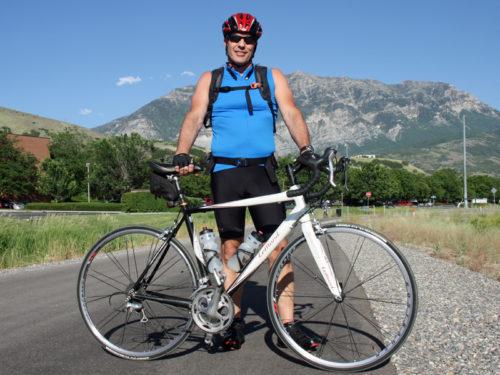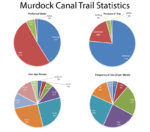
By Jamie Morningstar
Since his first days cycle commuting in 2009, Bruce Gladwin has logged over 15,000 miles riding to work and back. That’s the equivalent of riding from Utah to Panama every year; the miles sure do add up with regular cycle commuting!
Bruce rides from his home in American Fork to his office in Orem, a 12 ½ mile, 45 minute trip each way. Given his relatively long commute, Bruce rides a road bike to work – his trusty Lemond Zurich. Many people would shy away from exposing a full carbon frame to the rigors of daily commuting, but Bruce reports that his Zurich has stood up well and, aside from some wear on the wheels, shows few signs of wear and tear from the thousands of commuting miles he has logged.
Because of the length of Bruce’s commute, he wears cycling gear to and from work and carries a change of clothes in a backpack. He says that the nice thing about Utah commuting is that with the dry climate and cool mornings he doesn’t get too sweaty on his morning commute. When he gets to the office he towels off with a wet washcloth, changes into his work clothes, and is ready for the day. The summer evenings get hot and sweaty, but he doesn’t mind a warm return commute since he can hop directly in the shower when he gets home.
Bruce is a year-round cycle commuter. He rides “every chance I get” in the summer, which averages out to three or four days per week when factoring in work travel and holidays. In the winter he backs off to one or two days per week to avoid riding when there’s ice or snow on the roads.
Bruce also enjoys recreational cycling, riding in many of the big summer events with his friends on Team Cycle 4 Cure [link: teamc4c.org ]. His favorite summer events include the Ultimate Challenge and Front Runner Century and has also ridden in the ULCER and other local events.
For his first several years of cycle commuting, Bruce took surface streets and back roads to work. But with the opening of Utah County’s Murdock Canal Trail in 2013 Bruce’s commute changed considerably. He reports that although he has to backtrack a couple of miles to catch the trail, his slightly longer commute still takes the same amount of time as it did pre-trail because of the smooth path, straight shot, and comparatively few road crossings afforded by a dedicated multi-use trail.
About The Murdock Canal Trail
 The Murdock Canal Trail is a recent addition to the multi-use trail system in Utah County and has become an invaluable resource for many Utah County cycle commuters. To better understand trail use and experience, Cycling Utah interviewed Jim Price, the Trails Coordinator of the Mountainland Association of Governments, to learn more about the trail and its challenges and successes over its first two years of operation.
The Murdock Canal Trail is a recent addition to the multi-use trail system in Utah County and has become an invaluable resource for many Utah County cycle commuters. To better understand trail use and experience, Cycling Utah interviewed Jim Price, the Trails Coordinator of the Mountainland Association of Governments, to learn more about the trail and its challenges and successes over its first two years of operation.
The trail is a joint project between several public and local entities. The Provo Water Users Association owns the land and the now-enclosed canal, which runs from the Provo River to northern Utah County. Utah County operates the trail and seven cities of the Mountainland Association of Governments also help with maintenance, security, and trail operations.
The Murdock covers seventeen miles of paved multi-use path stretching from Lehi to Orem. To provide even better coverage across the whole county, there are plans to connect the Murdock Canal Trail to the Jordan River Trail in late 2015 or early 2016.
The path runs atop the canal and the result is a smooth and steady trail. One of the things Bruce likes most about the path is that regardless of which way one is riding the trail it’s a steady but gradual incline or decline. On his commute there are no major hills to “get real sweaty on”, as the only major climb on the Murdock is a short but steep descent and ascent near the north end of the trail in Lehi.
The Murdock Canal Trail has been extremely well-received and well-used. In the two years since its opening in May 2013, the trail has seen 1.9 million trips!
According to a recent weekday travel study of the Murdock Canal Trail, 19% of trail traffic is commuter-oriented with over half of users between the ages of 35 and 55. The majority (86%) of trail users live within two miles of the trail and cyclists make up 51% of overall traffic, making the trail an important resource for all Utah County cyclists and especially cycle commuters like Bruce.
The Murdock Canal Trail was clearly designed with cyclists in mind. For example, the gates at road crossings were designed to keep vehicles out while still allowing bikes to pass through without having to dismount. The trail includes restrooms every three miles, six paved trailheads with year-round parking, and water available during summer months every mile along with shade pavilions.
The trail is open year-round and even plowed in the winter. Usage remains high during the winter months and even in the frigid January of 2014 trail usage was 20% of its June peak with thousands of trips made that January, showing that hearty Utah County trail users appreciate the trail all year long.
In the almost two million trips made since the opening of the Murdock Canal Trail users have experienced remarkably few issues. No accidents between cars and trail users have been reported and the worst accident on the trail so far was when a cyclist ran into a crossing gate and injured himself.
Growing Pains
Avid commuter Bruce and trail coordinator Jim agreed on the same primary issues with the trail: unsafe road crossings and trail-sharing tensions between cyclists and other users.
Both Bruce and Jim stressed that cyclists must yield at road crossings; cyclists do not have the right of way at crosswalks. The Murdock Canal Trail has stop signs posted at every road crossing and it is each cyclist’s responsibility to slow, verify that there is no traffic coming, and stop if there are cars approaching.
Occasionally a car will stop to let a cyclist proceed. If it is plainly the case that the driver expects the cyclist to cross in front of them, and the road is clear on both sides, then it is usually fine to proceed. But cyclists should never expect or require cars to yield to them at road crossings.
Bruce says, “I slow down significantly at all crossings and stop if there are cars coming – because it only takes once. You have to ride defensively. It’s not a car’s responsibility to stop at road crossings. It’s our responsibility to stop and we should take that seriously. Slow and see if there’s any car approaching and if so, stop.”
Jim said that the community is very supportive of the trail, but when there are community complaints they generally come from local residents who have to slam on their brakes because a cyclist failed to yield at a crossing. Bruce reminds cyclists that, “It’s really not that hard to take your foot out of the clip” and it’s each trail user’s responsibility to yield to oncoming traffic.
There are a few street crossings, especially in Lindon and American Fork, where fences and trees occlude a trail user’s view of the road so severely that Bruce says he has to come to a complete stop because it’s not possible to see or hear traffic coming until he is right at the crossing. Jim also mentioned blind crossings as one of the issues that the the city and the county have been discussing. Better visibility at those few occluded crossings will improve each cyclist’s experience on the trail.
The second issue that both men mentioned are the natural struggles of a multi-use trail. Bruce’s biggest pet peeve is groups of pedestrians who spread wide across the trail. Jim noted that some trail users, especially older pedestrians, feel anxious about using the Murdock because, “cyclists zip close by pedestrians and startle them.” The Murdock Canal Trail was purposefully built much wider than average trails and at fifteen feet wide, “it’s plenty wide for cyclists to get away from pedestrians when passing them. Just be courteous. Call out or use a bell and move as far left as you can.”
Both Jim and Bruce discussed the idea of striping or painting lines on the trail. Bruce felt that lines would more clearly denote appropriate boundaries for pedestrians and stop them from stretching across the trail as they walk. Jim, however, said that there are no plans to stripe the Murdock Canal Trail. He said that, like unlined local neighborhood streets, an unstriped trail reminds people to take it slow. He said that often when there is a dedicated bike lane on a trail, cyclists will “put their heads down and not be aware of anyone else,” so the trail builders consciously chose not to paint lines on the Murdock Canal Trail.
And for Murdock users who are confused by the short jog through Highland Glen Park and the Alpine Highway in Highland, that was intended to be a temporary bypass. The trail was designed to go through the American Fork River Drainage but is dependent on a planned roadway going through the same area. The construction of the road has been delayed by the State Development Center in American Fork and once the road can be built then the trail will connect more directly.
Overall, the Murdock Canal Trail has been warmly embraced by cyclists, joggers, pedestrians, and the local community. It’s a fantastic new addition for area cycle commuters. Bruce sums up his experiences as a trail commuter by noting that the Murdock Canal Trail, “is a gem. Cyclists in any city would love to have a trail like this. You can go from the top of the Provo River trail all the way to the Jordan River. We’ve got a great trail system.”
Jim likewise referred to the Murdock Canal Trail as one of Utah County’s “crown jewels” and stressed that Mountainland Association of Governments is eager to hear suggestions and experiences from the community. Anyone can submit feedback about the trail at mountainland.org/site/contacts/send/jprice or can call Jim Price directly at 801-229-3848.
If you have a suggestion for a commuter profile, have a commuter question, or other comments, please send it to lou@cyclingwest.com.








